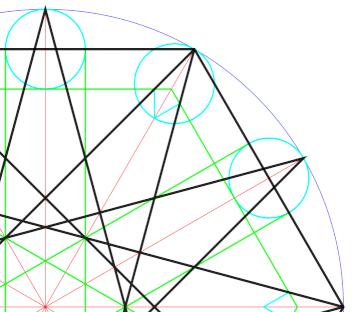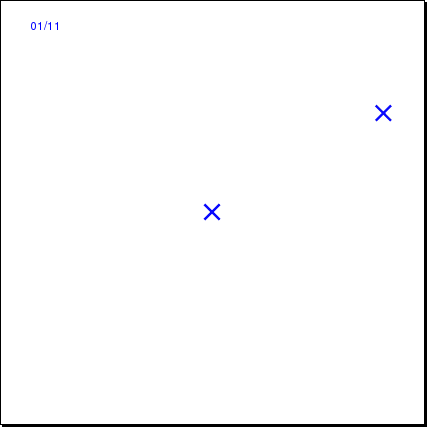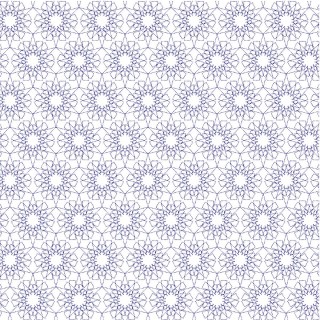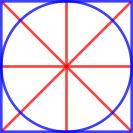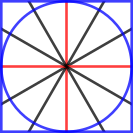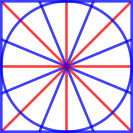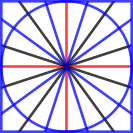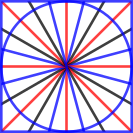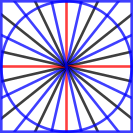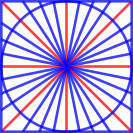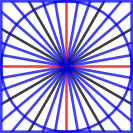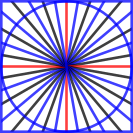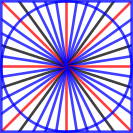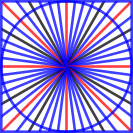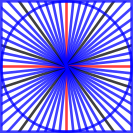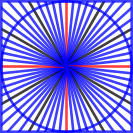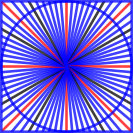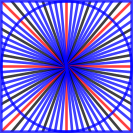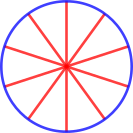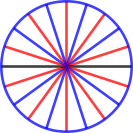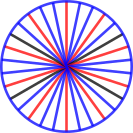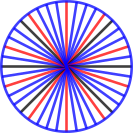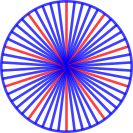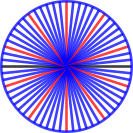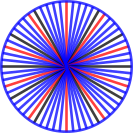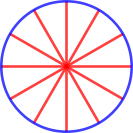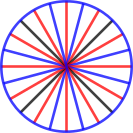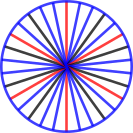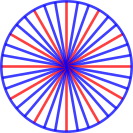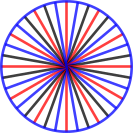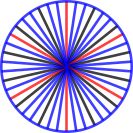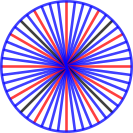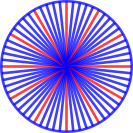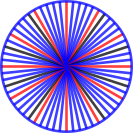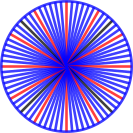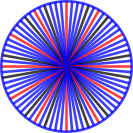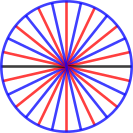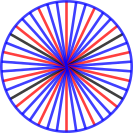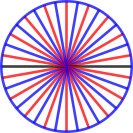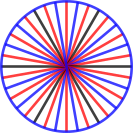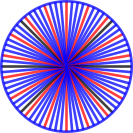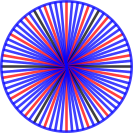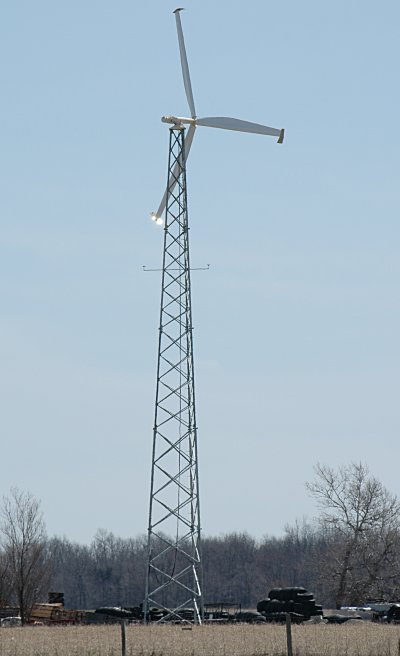Bitmap version on Flickr:
Tag: design
Inkscape: circles from a point and radius
Update: hey, you probably don’t want to do this too much. For complicated reasons, Inkscape (and Illustrator, and most other drawing packages) approximate circles with Bézier segments. These look like circles, but aren’t. If you need accuracy, use Inkscape’s Polygon tool and only use the vertices it creates. A lot of the patterns I was making round about the time I wrote this don’t quite tessellate properly.
Drawing a circle between a centre point and one on the circumference is a common requirement in working up geometric patterns. If you need lines parallel to a radial line, or indeed any line at a fixed distance from another point, you need to draw a circle as a construction guide. the figure below will never be destined for design greatness, but it shows how they could be used:
The turquoise circles define the green parallel lines, and also the smaller green hexagon inside the black one. Drawing circles from a centre is what compasses do, yet Inkscape doesn’t have a tool to do it easily.
There is a way around this, though, that I picked up from this forum post. The poster’s method isn’t very clear, but in very brief summary, you need to construct a 3 point or 2 line-segment polyline with its nodes equidistant from the centre point, then use Render → Draw from Triangle … → Circumcircle to construct the circle. Simple? Um …
Okay, dodgy animation and point by point explanation coming up. With cusp, intersection and centre snapping all enabled:
- Draw two points: one for the centre, one on the circumference
(I usually draw a short diagonal line as the pointand snap to the cusp node, as they are unobtrusive but easy to pick up the rotation centre.) - Click on the circumference point to select it
- Click on the circumference point again to select the rotation centre and handles
- Move the rotation centre of the point to the centre of your circle
- Duplicate the point (Ctrl+D)
- Rotate the point 90° (Object → Rotate 90° CW)
- Duplicate the new point (Ctrl+D)
- Rotate the new point 90° (Object → Rotate 90° CW)
(You should now have three points arranged around a semicircle) - Draw two straight line segments through the three points
- Select the line
- Render → Draw from Triangle … → Circumcircle — and there’s your circle.
There’s probably another way to do this by creating a point (Ctrl+click in Line mode) giving it a line width, setting rounded line ends, then doing Path→Stroke to Path to get a buffer around the point, but I can’t work out how to do this reliably.
Oh, and the patten I made from the construction? Well, it might look okay on a paper towel …
Islamic Radial Geometric Design: SVG Templates for Inkscape
These SVG templates are modelled after Eric Broug‘s drawing templates for Islamic Geometric Design pattern elements. Although written for Inkscape, they should be usable with almost any graphics program.
By enabling snapping to nodes and object centres, your drawing program can act like an accurate straight edge and compass for constructing geometric figures.
File Nomenclature
The files are name N-LL-S.svg, where:
- N — is the root symmetry: 4-fold, 5-fold, 6-fold, etc.
- LL — the total number of lines arranged evenly around the circle. This will always be a multiple of N.
- S — If the total number of lines has another symmetry that is a factor, this is S. If S = 0, then only the root symmetry is marked.
Examples:
4-12-6.svg— base symmetry 4-fold (square/diamond), with 12 lines or 30° spacing. Hexagonal (6-fold) guidelines are highlighted in a different colour.5-10-0.svg— base symmetry 5-fold (pentagonal), with 10 lines or 36° spacing. No other guidelines are highlighted.
Features
In Inkscape 0.91:
- units set to mm
- snapping set to cusp nodes, intersections, and object rotation centres
- construction lines on a separate layer (‘construction’) from the active layer (‘drawing’)
- templates are initially sized at 100 x 100 mm
- hair-line (0.1 mm) construction lines
Licence
WTFPL (srsly).
Files
All files, zipped: radial-templates-for-inkscape.zip
Individual files, with SVG linked behind image:
Tidied-up edition of Bourgoin’s Arabic Geometrical Design sourcebook on archive.org
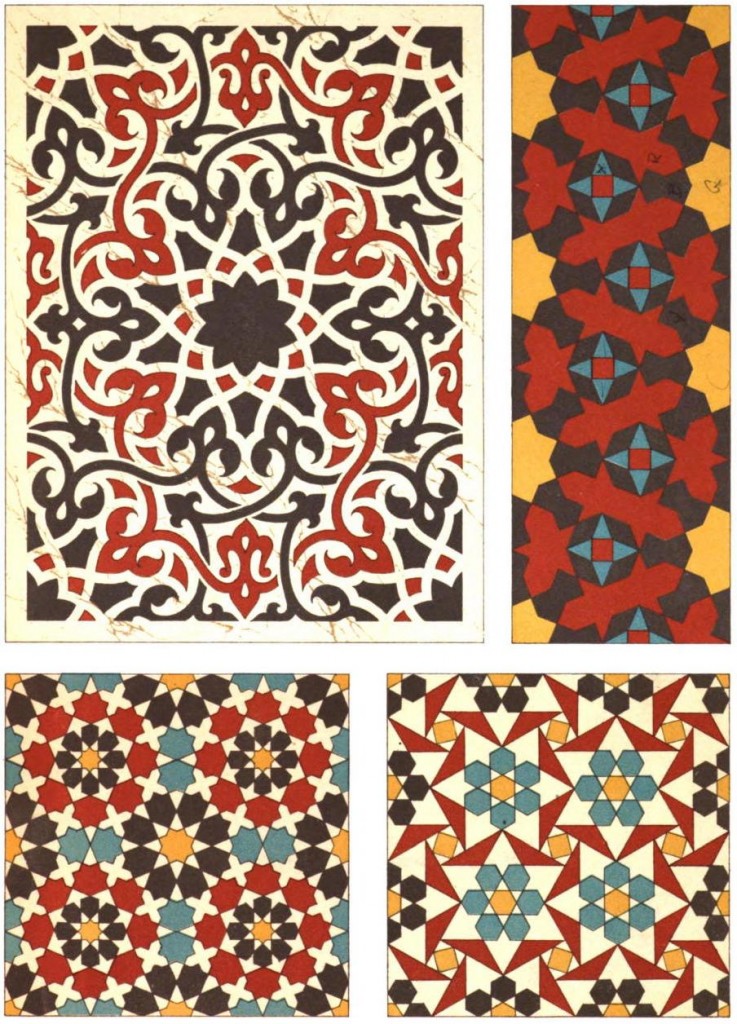 Just uploaded Les éléments de l’art arabe: Le trait des entrelacs by Jules Bourgoin (aka Arabic Geometrical Pattern & Design) to archive.org. This is much cleaned up from the Google Books scan, which had many duplicate pages and no metadata.
Just uploaded Les éléments de l’art arabe: Le trait des entrelacs by Jules Bourgoin (aka Arabic Geometrical Pattern & Design) to archive.org. This is much cleaned up from the Google Books scan, which had many duplicate pages and no metadata.
This is much better than the (now returned) Kindle edition …
AWS OpenWIND
AWS OpenWIND is a free wind farm design tool. It’s from people who know what they’re doing. I’m intrigued.
All the printers I’ve ever owned …

- An ancient (even in 1985) Centronics serial dot-matrix printer that we never got working with the CPC464. The print head was driven along a rack, and when it hit the right margin, an idler gear was wedged in place, forcing the carriage to return. Crude, noisy but effective.
- Amstrad DMP-2000. Plasticky but remarkably good 9-pin printer. Had an open-loop ribbon that we used to re-ink with thick oily endorsing ink until the ribbons wore through.
- NEC Pinwriter P20. A potentially lovely 24-pin printer ruined by a design flaw. Print head pins would get caught in the ribbon, and snap off. It didn’t help that the dealer that sold it to me wouldn’t refund my money, and required gentle persuasion from a lawyer to do so.
- Kodak-Diconix 300 inkjet printer. I got this to review for Amiga Computing, and the dealer never wanted it back. It used HP ThinkJet print gear which used tiny cartridges that sucked ink like no tomorrow; you could hear the droplets hit the page.
- HP DeskJet 500. I got this for my MSc thesis. Approximately the shape of Torness nuclear power station (and only slightly smaller), last I heard it was still running.
- Canon BJ 200. A little mono inkjet printer that ran to 360dpi, or 720 if you had all the time in the world and an unlimited ink budget.
- Epson Stylus Colour. My first colour printer. It definitely couldn’t print photos very well.
- HP LaserJet II. Big, heavy, slow, and crackling with ozone, this was retired from Glasgow University. Made the lights dim when it started to print. Came with a clone PostScript cartridge that turned it into the world’s second-slowest PS printer. We did all our Canadian visa paperwork on it.
- Epson Stylus C80. This one could print photos tolerably well, but the cartridges dried out quickly, runing the quality and making it expensive to run.
- Okidata OL-410e PS. The world’s slowest PostScript printer. Sold by someone on tortech who should’ve known better (and bought by someone who also should’ve known better), this printer jams on every sheet fed into it due to a damaged paper path. Unusually, it uses an LED imaging system instead of laser xerography, and has a weird open-hopper toner system that makes transporting a part-used print cartridge a hazard.
- HP LaserJet 4M Plus. With its duplexer and extra paper tray it’s huge and heavy, but it still produces crisp pages after nearly 1,000,000 page impressions. I actually have two of these; one was bought for $99 refurbished, and the other (which doesn’t print nearly so well) was got on eBay for $45, including duplexer and 500-sheet tray. Combining the two (and judiciously adding a bunch of RAM) has given me a monster network printer which lets you know it’s running by dimming the lights from here to Etobicoke.
- IBM Wheelwriter typewriter/ daisywheel printer. I’ve only ever produced a couple of pages on this, but this is the ultimate letter-quality printer. It also sounds like someone slowly machine-gunning the neighbourhood, so mostly lives under wraps.
- HP PhotoSmart C5180. It’s a network photo printer/scanner that I bought yesterday. Really does print indistinguishably from photos, and prints direct from memory cards. When first installed, makes an amusing array of howls, boinks, squeals, beeps and sproings as it primes the print heads.
almost as much fun as X-CAD Designer
Just played with QCAD for a bit, and remembered how much fun I had doodling with my ancient Amiga CAD package.

I’ll be your terrorist for the evening…
I’m at YYZ, and despite the Canadian passport, I’m still Mr Designated Searched Guy. Thought that the passport might’ve changed things, but no. Sigh…
It does mean I no longer have to do those dumb visa waiver things, yay!
And it didn’t help that part of one of the lighting panels started to fall off inside the cabin before takeoff, so we had to taxi back, get it fixed, and head back out an hour later. Gotta love Air Canada.
Sarah’s Solar Art
Sarah Hall works with glass and light, and her most recent commission for Regent College in BC combines solar photovoltaics and an LED light show into the installation. It’s a beautiful design, and I’d like to thank Sarah for inviting me to the official unveiling yesterday.
Hwy86 Turbine
This wind study brought to you by the Canadian Nuclear Association
So there’s a new report on wind integration in Canada, written by The Conference Board of Canada. People are picking up on it, and even the doughty Refocus quotes “… electricity from onshore wind is uneconomic in comparison with traditional alternatives“. Hmm.
So I read the report, and what do I find in the Preface?
As part of an ongoing initiative to investigate energy policy options and the future of the Canadian energy system, the Canadian Nuclear Association contracted The Conference Board of Canada to conduct a comparative study of various countries’ experiences with supporting and implementing large-scale wind projects.
So we’re expected to believe that the CNA would wish to have an objective and non-partisan report written on wind power, eh?
big windfarm, big deal
So there was a stramash that the RSPB published a map showing where the Lewis wind farm would reach if it started in Edinburgh. Oh noes! Looks like it’d go all the way to Methil.
I’ve been working on a couple of medium-sized wind farms in Ontario. For top laughs, I tried overlaying them on Scotland, using streetmap.co.uk for the measurements.
Since I’m a weegie, I started at George Square. One of the farms would stretch all the way west by Wishaw, near Murdostoun Castle (and the comically-named town of Bonkle). The other would run north to somewhere between Fintry and Kippen, in Stirlingshire.
For those of you unlucky enough to be based east of Falkirk, I tried the same starting at Edinburgh Castle. The first wind farm would run west to the hamlet of Gilchriston, which is just north-west of Dun Law Wind Farm, which I worked on in the distant past. (If you run the farm west from Edinburgh, you end up in Bo’ness, which no-one would want to do.) The other design would end up somewhere between Kirkcaldy and Glenrothes, near Thornton — and not that far from Methil, a distance that the RSPB would have us believe is just too far for a wind farm.
So, where’s the news, RSPB? How did your land get somehow more precious than ours?
all around the lakes
Had an impromptu visit to Port Burwell today to fix a cranky cell modem. It was also my first experience of driving a stick shift — and not just any stick shift, one with 400Kclicks on it — on the wrong side of the road. It was weird, but since I neither wrecked the car nor hit anything, I think I got the hang of it.
Anyway, no trip to Burwell is complete without a visit to the Lighthouse Restaurant for fresh fried lake perch. While I was there, I got chatting to a couple from Chicago who were working on their plan to cycle round a Great lake each summer. By doing this, they were hoping to appreciate the scale of these huge bodies of water. Neat plan.
One day, when I’m a Celebrity Windfarm Designer with my own television show, I’ll take a summer off to go round Lake Erie.
Eyetap wins Coram Design Award
Steve Mann, et al have just won the 2004 Coram Design Award for sustainable design. Yay!

